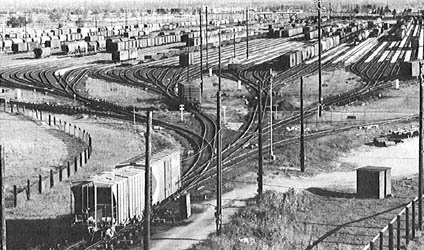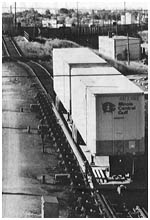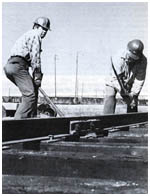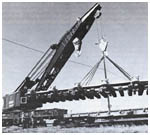
Public Relations and
Advertising Department
Windsor Station Montreal Que. H3C
3E4
|
Volume 10
Number 15
|
November 19,
1980
|
|
Toronto Yard Makes Changes to
Meet
Challenge of the 80's
By Stephen Morris

Every Which Way: Handling
about 3,300 cars a day, the hump track feeds into 72 classification tracks. To
ensure safety, a series of retarders act as brakes so that cars couple at no more
than four miles per hour.
TORONTO - The Toronto Yard is an
important link on the Eastern Region and as the use of rail transportation increases
the yard is changing to meet the challenges of the new decade.
| |

The
Hump
|
A new caboose shop has been built to handle repairs for run-through
and local cabooses.
A closed-circuit television scanner system, which sports a $158,000
price tag, has been installed to improve the method of identifying and checking
freight cars entering the yard. The system can identify cars moving at speeds up to
60 miles per hour.
IMPROVEMENTS
And the improvements don't stop there.
A multi-million YARDS (Yard Activity Reporting and Decision System)
computerization program, which might be implemented next year, has been developed
to improve the yard's capacity to handle the increasing number of rail cars.
| |

Engine
Overhaul
|
At present the yard has a marshalling capacity of 150,000 cars a year and more than
1,200 employees, representing all railway trades, are employed at this
432-acre site.
Patterned on the same design at the 30-year-old St. Luc Yard in
Montreal, the Toronto Yard, which was built in 1964 at a cost of about $17 million,
was the second major classification hump yard built by the company. It remains one
of the most advanced in North America.
| |

A Little
Muscle
|
MAJOR FACILITY
Also known as the Agincourt Yard because of its location in the Agincourt borough
of Scarborough, the Toronto Yard serves the industrial heartland of southern
Ontario by acting as a major freight car distribution facility for goods moving
north, east, and west. Trains arrive here from points as far away as Saint John,
N.B. and Vancouver B.C.
An obvious feature of the yard is the hump. While coming down the hump, freight cars
pass through two retarders which brake the units and prevent them from increasing
speed. These humping movements are normally made as a speed of 2.5 miles an hour
with coupling taking place at no more than 4 miles an hour.
| |

Heavy
Move
|
The hump yard is designed to handle about 3,300 cars a day and, with its 90 miles
of track, has a standing capacity of more than 5,100 freight cars.
The Toronto Yard also serves as a major repair facility on the Eastern Region
with a 34,000 square foot diesel shop and a 49,200 square foot car repair shop.
Last year, the car shop performed about 36,000 repairs on CP Rail and foreign road
freight cars. The diesel shop, with its five tracks, services and repairs 220
diesel locomotives which operate in and out of the Toronto area.
At a classroom located in the diesel shop, full-time instructors teach
employees enrolled in the company's apprenticeship training programs.
This CP Rail News article is copyright 1980 by
Canadian Pacific Railway and is reprinted here with their permission. All
photographs, logos, and trademarks are the property of the Canadian
Pacific Railway Company.
|